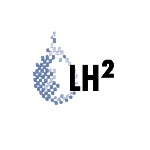Assessment of hazardous gas emission to the surface over former mined areas
- Projektbeschreibung
-
The numerical model MUFTE-UG which is capable to simulate two-phase, gas and water, flow processes in the subsurface has been adapted to the special conditions of methane gas problem. Several simplified test cases have been carried out to determine sensitive parameters depending on the geological structures. In Figure 1 the temporal development of the methane gas saturation driven by a methane source (idealized mining area) is shown for a system consisting of four different layers with fault zones.
Figure 1.: Permeability and methane gas saturation after 40, 60, 80, 120, 180, 270 and 420 days
In a close cooperation with DMT it is planned for the next period to continuously integrate real case data (see Figure 2) in order to investigate the influence of fracture-networks as well as to estimate the influence of small scale heterogeneities on the methane migration processes through the subsurface, the amount of gas escaping to the atmosphere respectively.

Figure 2.: 3D model
The numerical model MUFTE-UG which is capable to simulate two-phase, gas and water, flow processes in the subsurface has been adapted to the special conditions of methane gas problem in coal mining areas. In a close collaboration with DMT several simplified test cases have been determined and carried out to investigate the influence of different permeabilities, layers with different permeabilities, inclinations of layers, fault zones as well as methane source terms on the gas-water flow processes.
Thus, sensitive physical and numerical parameters have been determined. The geological structures as well as the methane source term have an important influence on flow processes, the amount of methane gas escaping to the atmosphere as well as its locations at the surface of the earth.
In figure 1 the migration of methane gas driven by a source term which is an idealized mining area is shown. The system consists of four different layers with decreasing permeability from bottom to top and fault zones (see top left). Initially, the system is fully saturated with water. From left to right and top to bottom the temporal development of the methane gas saturation is presented. Due to the lower density, the methane vertically flows up to the layer with the lower permeability. Then, it spreads horizontally, more to the right than to the left because of the layer inclination. As soon as the fault zone is reached, it further moves upwards. The methane enters the upper layer, if the entry pressure of the layer is exceeded. At the next layer which has no inclination an equal horizontal movement of methane to the left and right is observed. Finally, it reaches the surface of the earth through the upper right fault zone.
For the next period, two things are planned in a close cooperation with DMT. On the one hand, a 3D model of an existing coal mining area will be built up and prepared for the numerical simulation. This requires the collection of available data, their integration into a CAD system (see fig. 2, two cuts through a coal mining area in the Ruhrgebiet, Germany), a data base and a mesh generator. On the other hand, the influence of fractures, fracture-networks and small scale heterogeneities on the methane migration processes will be investigated.
- Leitung
-
Hinkelmann, Reinhard
- Stellvertreter
-
Helmig, Rainer
- Bearbeiter
-
Breiting, Thomas
Kobayashi, Kenichiro - Abteilung
- Zeitraum
-
01/2000 - 04/2004
- Finanzen
-
ECSC coal RTD Programm
- Partner
-
IMC-TS, Co-ordinator
DMT GmbH
INERIS
Deutsche Steinkohle AG
Imperial College
Wardell Armstrong
University of Nottingham
Central Mining Institute
Kontakt



